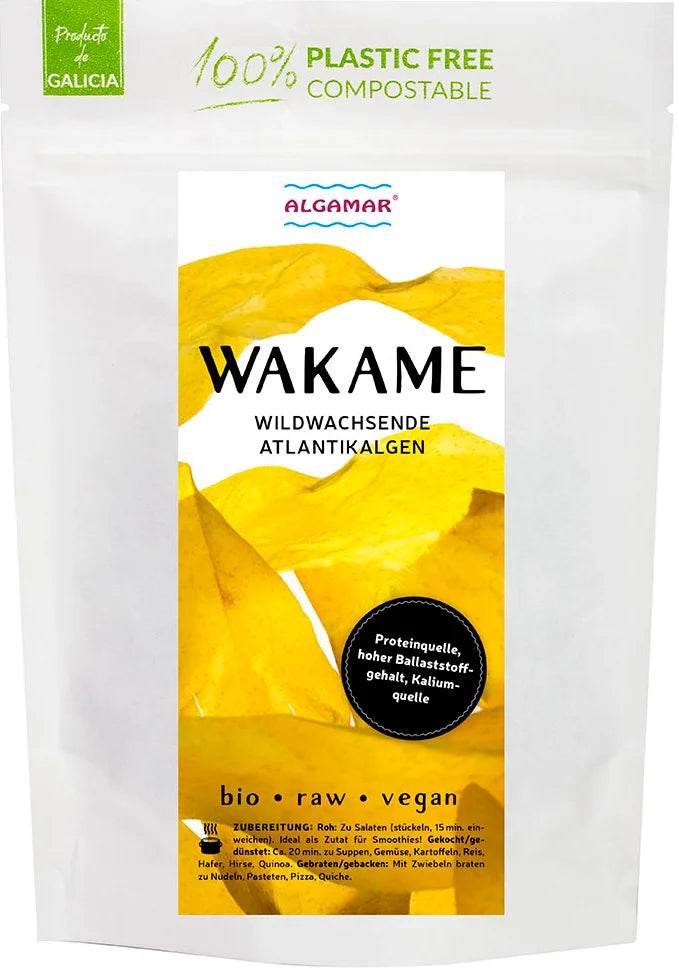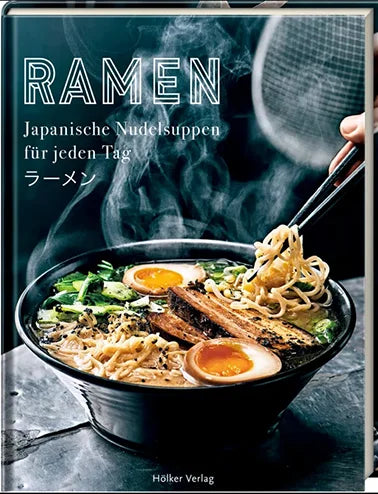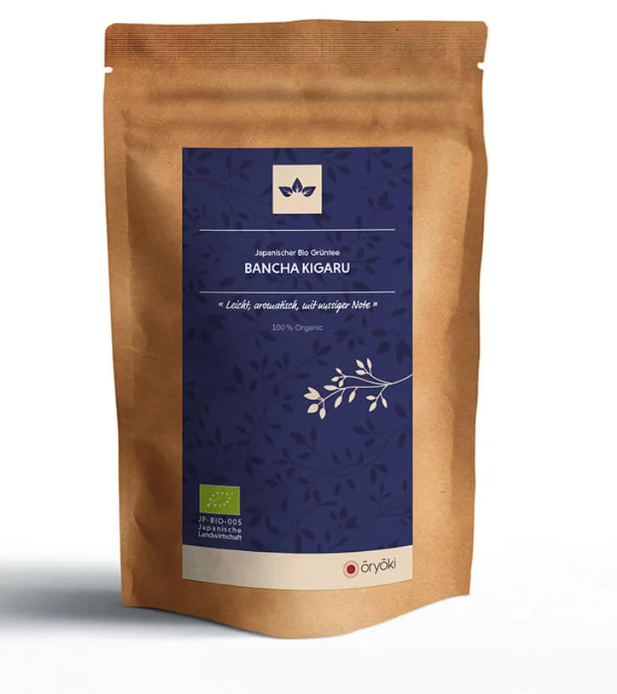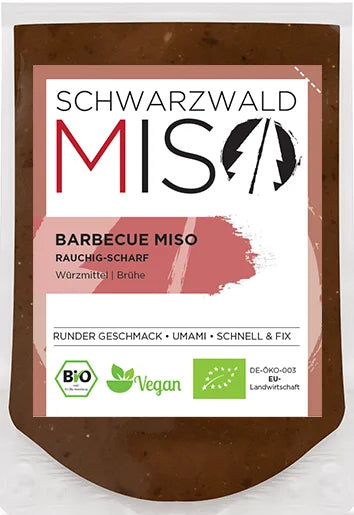Auswahlhilfe und Anwendung
Kochen mit Schwarzwald-MISO
Lieber Kunde,
dieser Leitfaden hilft dir dabei, dich für die richtige Miso Paste zu entscheiden. Es erklärt dir die Unterschiede zwischen den einzelnen Pasten und gibt dir hilfreiche Tips zur Anwendung. In Kochbüchern und Rezepten stehen oft japanische Sortenangaben zu Miso Pasten. Aber welche Bezeichnung entspricht welcher Paste bei Schwarzwald-MISO, genau das erklären wir dir hier. Außerdem die typischen Anwendungsfälle in der Küche und hilfreiche Tips & Tricks zum Kochen mit MISO.
Liebe Grüße
MISO Peter
Themen
Grundsätzlich kann Miso in fast allen Gerichten eingesetzt werden, in denen Salz, Gewürze, Brühe, Fleisch, Fisch, Tofu, Gemüse und Salat verwendet wird.
Reis Miso | MISO MILD-WÜRZIG
Unser Reis Miso ist ein mild würziges Miso. Es besteht aus 50 % weißem Reis und 50 % Sojabohnen und einem Salzgehalt von 10,8 %. Es bringt eine milde Grundwürze in jedes Gericht. Daher verwenden wir es gerne als Standardwürzmittel in der Küche.
Tipp: Wir empfehlen dir, mit diesem Miso zu starten, wenn du noch keine Erfahrung mit Miso Pasten hast.
Soja Miso | MISO WÜRZIG
Unser Soja Miso besteht aus 100 % Sojabohnen vom Bodensee. Mit einem Salzgehalt von 12 % gibt es eine aromatische Grundlage. Eine stärkere Würze als das Reis Miso und daher perfekt für dunkle und kräftige Suppen sowie Marinaden und Grill Saucen.
Gersten Miso | MISO WÜRZIG-MALZIG
Das Gersten Miso schmeckt leicht malzig und besteht aus 50 % Gerste und 50 % Sojabohnen mit einem Salzgehalt von 10,8 %. Wir empfehlen es besonders zum Marinieren von Fleisch (ideal auch für Fleischersatz) und als Grundlage für herzhafte Saucen.
Lupinen Miso | MISO SÜß-BLUMIG
Ein helles blumiges Miso, das komplett auf Sojabohnen verzichtet und stattdessen aus 50 % Lupinen und 50 % weißem Reis besteht. Ideal für den Einsatz in hellen Saucen & Brühen sowie unsere Empfehlung für Salatsaucen. Die perfekte Verbindung mit Butter als Miso Butter sowie in Sauce Hollandaise und Miso Mayonnaise.
Tipp: Dies ist unsere zweite Empfehlung für Miso Neulinge – dass Lupinen Miso ist ein guter Start in die Miso Welt.
Miso mit Gewürzen, auf der Grundlage von Reis Miso
Das Miso Mediterran eignet sich hervorragend für alle mediterranen Gerichte, italienische Pasta, Tomatensauce, Fischgerichte, Antipasti, Vorspeise und Salate. Das Miso enthält Oregano, Thymian und Basilikum. Die Gewürze verstärken sich durch die Lagerung, d.h. diese Gewürze sind sehr kräftig. Um ein zu starkes Übertönen mit dem Eigengeschmack der Zutaten zu verhindern, empfehlen wir eine sparsame Verwendung oder eine Mischung mit milderem Miso.
Das Ingwer Curry Miso macht seinem Namen alle Ehre. Ein ausgeprägter leicht fruchtiger Geschmack, perfekt für die Kürbiscremesuppe, aber auch für Currywurst, Reis Gerichte aller Art, sowie Gemüse (z.B. Lauch, Karotten, Sellerie).
Unser Mexi Chili Miso ist angenehm scharf, bringt eine gute Grundwürze in jedes Gericht. Es ist eine sehr milde angenehme Würze, für alle. Ideal für kräftige Tomatensaucen, der Klassiker für (scharfe) Grill Saucen (Miso, Tomatenmark, Senf, Essig, Öl, Wasser) und Pasta Gerichte.
Das Miso Mare mit Meeresalgen hat besonders viel Umami; dafür kochen wir den Sud aus der Kombu Alge und geben es dem Miso hinzu. Daneben enthält es gekochte und zerkleinerte Algen (Wakame, Meeres-Spaghetti, Dulse). Es eignet sich daher für Fitness-Salate, Fischgerichte und alle Speisen, die besonders viel Geschmack benötigen.
Tipp: Der Klassiker für die Miso Suppe
Spezial Miso
Neben unseren vier Klassikern gibt es immer wieder neue Kombinationen, die wir für euch entwickeln.
Das Miso Intense, eine Mischung verschiedener MISO Sorten -zeichnet sich durch einen intensiven Umami Geschmack aus. Die Zusammensetzung variiert zwischen den einzelnen Chargen
Tipp: Grundsätzlich verstärken sich alle Miso Sorten gegenseitig, daher bringen Mischungen zwischen den einzelnen Pasten noch mehr Geschmack.
Unser Alblinsen Buchweizen Miso gibt einen leicht erdigen Geschmack und harmoniert daher sehr gut zu Wild-, Pilz- und Schmorgerichten. Die Linsen sowie der Buchweizen stammen von der Schwäbischen Alb.
Das Süße Vollkorn Miso (aus Vollkornreis und Sojabohnen) zeichnet sich durch einen vollmundigen Schokolade-Karamell-Geschmack aus und harmoniert daher super in herzhaften Gerichten, bei dunklen Saucen sowie sparsam in Dessert Varianten.
Das Veilchen Miso mit frischen Keltenhof-Veilchen auf der Basis von Lupinen Miso eignet sich hervorragend für eine frische Frühlings- und Sommerküche. Perfekt für Miso Hollandaise, Miso Butter zu Spargel, zu Grillgemüse und Fleisch.
Das BBQ Miso ist auf der Basis unseres Soja Miso und enthält daneben noch schwarzen Pfeffer, Chili, Rohrzucker und Rauchpaprika. Ideal in Verbindung mit Senf, Tomaten und Tomatenmark, Wasser, Essig und Öl – als Grillsauce oder Marinade.
Wer das MISO Kochbuch von Claudia Zaltenbach verwendet, stößt auf japanische MISO Bezeichnungen. Im Folgenden werden diese kurz erklärt, und es wird auf die jeweils passende Alternative von Schwarzwald-MISO hingewiesen.
Das Aka Miso ist mit unserem Reis MISO vergleichbar- obwohl hier traditionell das Verhältnis 70 % Sojabohnen und 30 % Reis verwendet wird, mit einem Salzgehalt von 13 %.
Ein stückiges Miso, das noch Stücke von Soja und Reis enthält, ist das Inka Miso. Es hat kein definiertes Mischungsverhältnis und wird typischerweise in Privathaushalten hergestellt. Hier empfehlen wir unser Reis MISO.
Das Shiro Miso ist ein MISO mit einem sehr hohen Reisanteil über 80 % und nur einem geringen Anteil an Sojabohnen. Es ist nur kurz – ca. 3 Wochen gereift. Länger gereift wird es oft als Shinshu Miso bezeichnet. Hier empfehlen wir unser Lupinen MISO, das ist zwar deutlich länger gereift – passt aber durch seine helle Farbe und seine süß-blumige Art perfekt als Ersatz dafür.
Das Mugi Miso entspricht unserem Gersten MISO, anstatt Reis wird Gerste verwendet. Das Mischungsverhältnis bleibt gleich.
Als Genmai Miso bezeichnet man Miso mit braunem Reis anstatt geschältem. Dem entspricht unser süßes Vollkorn Miso.
Als Awase Miso bezeichnet man eine Miso Cuvee, die aus verschiedenen Misos zusammengemixt wird. Hier haben wir mit dem MISO Intense ein entsprechendes Produkt im Sortiment.
Ein Miso nur aus Sojabohnen und einer langen kräftigen Reifezeit wird als Hacho Miso bezeichnet. Unser Soja Miso ist ein entsprechendes Produkt.
Wasserlöslich
Die Miso Paste ist grundsätzlich wasserlöslich – sie lässt sich mithilfe einer Gabel in Wasser auflösen. Die Wasserlöslichkeit ist unabhängig von der Temperatur – die Paste löst sich daher im kalten Wasser genausogut wie im heißen.
Fettlöslichkeit
In Verbindung mit Fetten ist die Paste nur sehr begrenzt löslich. Allerdings harmoniert sie geschmacklich hervorragend zu Butter, Öl, Sahne und Joghurt. Auch in Salatsaucen wird sie gerne verwendet – ein Gemisch aus Miso, Öl und Wasser.
Eine Emulsion lässt sich aus Wasser und Öl mit wenig Sojalecithin oder Eigelb herstellen, dies wird dem Miso beigemischt.
Geschmackverstärker
Miso ist ein natürlicher Geschmacksverstärker (Umami). Dies liegt am hohen Glutamingehalt der Miso Paste. Glutaminsäure, auch in Tomaten vorhanden, verstärkt den Eigengeschmack fast aller Speisen.
Anwendung nach dem Kochen (Standard-Methode)
Unsere Pasten können am Ende der Kochzeit zum Abschmecken von Saucen verwendet werden. Hier ist die Empfehlung ein Teelöffel MISO Paste auf 0,1 Liter Flüssigkeit. MISO gibt jedem Essen Tiefe und verstärkt den Eigengeschmack aller Zutaten – ohne geschmacklich zu dominieren.
Anwendung beim Kochen
Bei Gerichten, die sehr lange garen, kann das Miso zu Beginn in der Flüssigkeit aufgelöst werden. Hier ist die Mengenempfehlung gleich. Dadurch entsteht eine Tiefe im Gericht vergleichbar dem Schmoren (kombiniertes Garverfahren aus Anbraten und anschließendem langen Garen in Flüssigkeit), das oft mehrere Stunden dauert.
Anwendung als Dressing
Dazu einen halben Teelöffel Miso Paste mit der gleichen Menge an Öl, Essig und kaltem Wasser verrühren. Dieses Gemisch ist ein leckeres Salatdressing – die Fetttröpfchen sind sichtbar. Eine Emulsion mit Senf oder einem Emulgator (Soja-Lecithin) ist möglich. Dressings auf MISO Basis sind lecker und leichter als Sahne oder Joghurtsaucen.
Anwendung als Marinade
Miso eignet sich als Marinade für Fleisch, Fisch und Fleischersatz. Wir empfehlen grundsätzlich die Sorten Reis MISO (allgemein), Soja MISO (dunkles Fleisch) sowie Lupinen MISO (helles Fleisch, Fisch).
Hier hat der Einsatz von MISO zwei Vorteile. Das Fleisch wird zart und weich, Miso verstärkt den Eigengeschmack deutlich und das ganze wird leichter verdaulich. Dieser Effekt wird ab 10 Min Einwirkzeit erzielt und verstärkt sich bei längerer Einwirkzeit. Für Fleisch empfehlen wir 2 Stunden. Vor dem Grillen muss überschüssige Marinade wieder entfernt werden, da diese bei hoher Temperatur schwarz wird.
Anwendung als Suppe
MISO Paste ist die Grundlage der MISO Suppe. Im Gegensatz zu fast allen Rezepten dazu ist eine Zugabe von Dashi (Algen und Thunfischflocken) nicht notwendig. Das ist die klassische japanische Variante der MISO Suppe.
Viele unserer Kunden trinken die MISO Suppe pur: nur MISO Paste und heißes Wasser - als Energiedrink am Morgen und zwischendurch als Kraftgeber und Muntermacher. Sie tauschen eine Tasse Kaffee am Tag gegen eine Tasse MISO Brühe. Auch können in Kombination mit Gemüse, Nudeln, Fleisch, Fisch, Tofu leckere Suppen sowie die japanischen Ramen zubereitet werden.
Die MISO Paste wird gefriergetrocknet – dadurch entsteht ein konzentriertes Pulver (der Wasseranteil verdunstet), das als Tischgewürz und als Streuwürze sehr ergiebig einsetzbar ist. Beim Würzen mit dem Pulver reicht oftmals bereits eine Prise aus. Das Pulver kann im Urlaub oder im Geschäftsalltag auch als schnelle MISO Suppe auf Pulverbasis verwendet werden. Allerdings ist es in Verbindung mit Wasser weniger ergiebig als die Miso Paste. Der große Vorteil ist, dass keine Klümpchen entstehen und das Pulver hochdosiert punktuell eingesetzt werden kann.
Abschluss
Wir wünschen dir viel Spaß beim Entdecken der Möglichkeiten – Willkommen in der Welt von Schwarzwald-MISO.
"Vielen Dank auch an unseren Kunden Dietrich May der großen Anteil bei der Erstellung dieses Leitfadens hatte und uns
durch seine Ratschläge, Kocherfahrungen und Klarheit zur Seite stand."
Was bedeutet:
Der Geschmack von Miso wird oft als Umami bezeichnet. Neben salzig, süß, bitter und sauer bezeichnet Umami einen runden und ausgewogenen Geschmack – wie er normalerweise erst nach langen Koch Vorgängen entsteht. Mit Miso ist es möglich, diesen Geschmack schnell und vegan zu erhalten.






